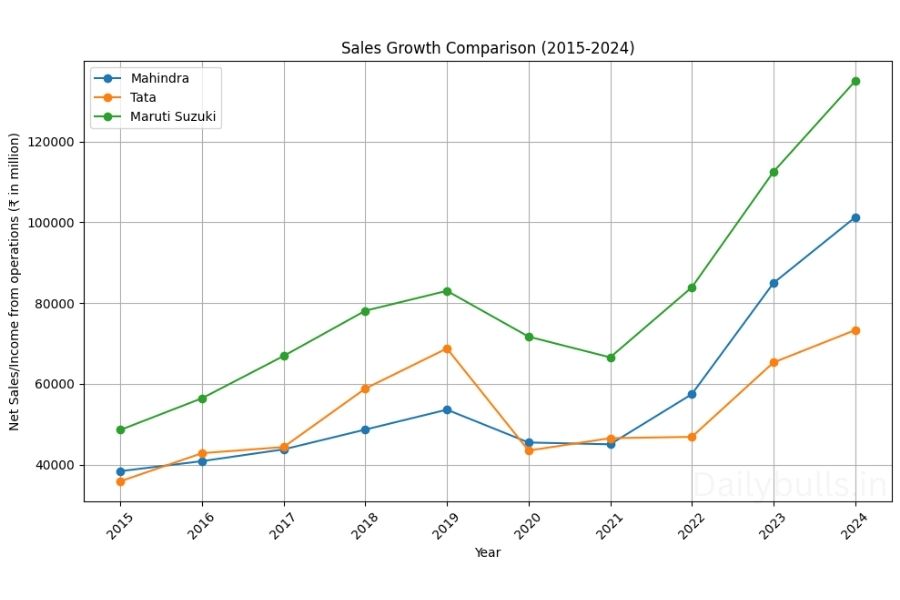
How new Design Team saved Mahindra’s Market Share – Case Study
Dailybulls Research
Contributor
The Indian automobile industry is highly competitive and evolving rapidly. In 2023, India became the third largest automobile market in terms of sales. With the market filled with domestic and global giants, Mahindra & Mahindra was seeing a decline in its market share. With an overall slag in growth and demand in the Indian market, Mahindra’s passenger vehicles market share fell to 9.4% in 2021, from 11.2% in 2019.
M&M which is well known for its commercial vehicles, and has been performing relatively well since the past few years in the heavy vehicle segment. The company’s market share for commercial vehicles was relatively higher (14.6% in 2021 compared to 9.4% share in passenger segment)
Even with the strong positioning and brand value for rugged pick-ups like bolero and popular passenger cars such as XUV500 & Scorpio, Mahindra found itself steadily losing its sales even in the utility (commercial) vehicle segment. They lost nearly 65% of share by the end of FY 2020. The company recognised that, while their products were reliable and capable, they needed to work on the aesthetics, especially for the consumer segment.
The new aspiring India wants their cars to look good. Research shows that consumers consider the attractiveness of a vehicle as one of the main factors while making a purchase. As the Indian automotive market is maturing and the quality of vehicle are improving, consumers are shifting their focus from just quality and durability to styling and technology. 1
In response to the situation, Mahindra made a strategic decision which involved overhaul of its design team – a move that would prove transformative for the company’s future. This case study examines how this organizational change helped Mahindra not only to defend its market position but to grow its market share in India’s tough automotive sector. As students of finance, our aim is to learn how changes in management of a company might reshape the path for a company.
Why India want good looking cars?
India is witnessing a shift in trend towards premium products, especially among millennials. Younger consumers aspire for stylish products that reflect their personal life and status. Despite economic uncertainties, country’s large millennial population is highly aspirational and desires visually-appealing vehicles to showcase their individuality. 2
Desire to Make a Fashion Statement
Consumers, particularly enthusiasts, highly value the exterior styling of their vehicles as a way to make a fashion statement. Each manufacturer is trying to gain an edge by producing highly styled vehicles that reflect the evolving tastes and aspirations of Indian consumers. 1
India's Potential as a Design Hub
India has the potential to become a global hub for automotive design and styling, like China and Brazil. With strengths in IT and a rich cultural heritage, India can leverage its design capabilities to produce world-class, indigenously-designed vehicles that cater to both domestic and international markets. The government and industry are taking steps to promote automotive design and build the necessary talent pool and infrastructure. 3
Increased Competition and Need for Differentiation
The Indian automotive industry is becoming increasingly competitive, with many national and multinational players vying for market share. In this context, exterior styling is emerging as a key differentiator for consumers as they decide on their next vehicle purchase. Attractive, fresh styling can help boost sales even if the vehicle’s quality ratings are not top notch.
How changing the Design Team helped Mahindra regain its market share
In June 2021, M&M appointed Pratap Bose as the Executive Vice President and Chief Design Officer. Bose, who had previously worked with Tata, was to lead Mahindra‘s newly formed Global Design organization.
Earlier in his career, Bose has worked with well known Italian brands such as Piaggio & C.SpA (known for Vespa). During his tenure at Tata, Pratap Bose was also involved in designing cars like Tiago, Tigor, Nexon, Harrier, and Safari, all which were very successful.
His move to Mahindra was seen as critical to help drive growth in new areas like electric vehicles and revamp the design language of the Mahindra vehicle range.
Setup of new design centers in 2021 led by Bose
M&M set up the Mahindra Advanced Design Europe (M.A.D.E) center in the UK in July 2021. This was a part of the Mahindra Global Design Network that also includes the Mahindra Design Studio in Mumbai and Pininfarina Design in Italy. The new centre aimed at sharpening Mahindra’s product designs.
In August 2021, M&M unveiled a new visual identity and logo for its SUV portfolio, designed by the Mahindra Design Team under Pratap Bose’s leadership. The “Twin Peaks” logo and visual identity were created to reflect M&M’s focus on building authentic, sophisticated, and tough SUVs.
These changes in the design leadership and strategy have been lead by key executives like Anish Shah (MD & CEO of Mahindra Group), Rajesh Jejurikar (Executive Director for Auto and Farm Sectors), and Veejay Nakra (CEO of the Automotive Division) to make the brand more premium, modern, aspirational and tech-enabled.
What changed for Mahindra?
Between 2021 and 2024, all automobile players experienced sales recovery after covid-19 as it was cheaper to borrow money. However, the growth trajectories are different for Tata, Mahindra and Maruti Suzuki.

Mahindra demonstrated exceptional performance, with its sales skyrocketing by 282%, from ₹45,040.98 million in 2021 to ₹101,219.42 million in 2024. On the other hand, Tata’s saw a modest growth of 21% over the same period. Mahindra’s refreshed designs led to aggressive recovery and market expansion post-2021 clearly outpaced Tata’s. Before 2020, M&M’s growth was stagnant, and undeformed other Indian companies.
The above graph shows Mahindra’s total market share in India from 2016 to 2023. Prior to 2021, M&M maintained a relatively stable market presence, with shares fluctuating between 10.9% and 11.8% from FY16 to FY19, followed by a slight dip to 10.8% in FY20. The post-2021 period, however, saw more dramatic shifts. FY21 marked a significant downturn with market share dropping to 9.4%, likely due to the COVID-19 pandemic’s impact. This decline was short-lived, as M&M demonstrated a strong recovery in subsequent years. FY22 saw an increase to 10.7%, followed by a substantial jump to 12.6% in FY23. This rebound not only recovered lost positions but accelareted M&M to a stronger market position than it held before the pandemic.
Supported by improving economic conditions post Covid and fueled by transformed design language, Mahindra saw impressive growth numbers post 2021. As investors, it becomes important for us to keep tracking such key management changes in the companies as they may prove to be a strong tailwind.
Share this insight
Spread the Alpha
If this analysis helped you, pass it along to your trading desk or community.






